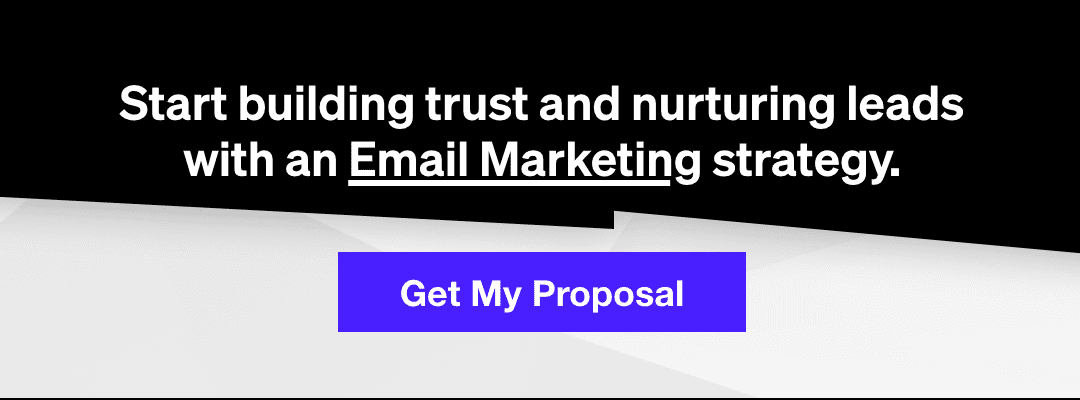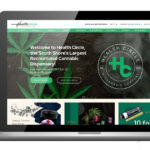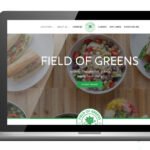If you’ve ever fretted over the placement of a single exclamation point or whether you can use a cheeky emoji in a message to your boss, you’ve experienced the gravity of email in the modern marketplace.
But even more critical than a message to a colleague? The follow-up and nurture email sequences companies write to budding customers. According to Oberlo, the ROI on email marketing is massive: each $1 spent later pulls in $40 on average.1
Automated email sequences do the work of welcoming new subscribers, introducing them to what a brand stands for and what users have to gain from the relationship. The following email sequences are some of the most essential for any business that wants to earn its stripes in any inbox—no handwringing about exclamation point use necessary.
#1 The greeter
A good nurturing email lead can start with a greeter. A kindhearted “Nice to meet you” message starts business-client relationships off on the right foot.
Whether it’s got the tone of a good, firm handshake or a warm hug, greeter sequences add a human touch to commercial relationships many users have come to regard as robotic (yes, even though those welcome sequences are automated). Indeed, branded Welcome emails have some of the highest open rates of the bunch, to the tune of 68.6% on average.1
A greeter message should arrive when a customer signs up for a site or subscribes to services, to confirm and thank them for their choice. A well-written one should include:
- A wholehearted “Thank you” – Customers like to feel appreciated by the businesses they decide to patronize. Thanking every user individually is a kind gesture businesses can use to show that support is valued.1
- Information about the services purchased – While users should already have a complete picture of what they’re paying for, a little recap is always helpful. Consumers crave transparency in their purchases.2 Laying out exactly what they have access to, how to use different features and how to get the most value for their purchase is a key component of greeting emails.
- Relevant offerings – A welcome email is an excellent opportunity to introduce a new client to the other services and specialties a business has to offer. Making mention of complementary services or other available products can help users gain more value from what they’ve already invested in while helping to foster customer retention.
Truthfully, every other nurture email sequence won’t land as well if a welcoming greeter sequence hasn’t been delivered first. Just like any other social encounter, you have to make an introduction before you can have a conversation.
More importantly, when a client receives a tailored greeting message, they feel welcomed and part of more than just a one-way digital relationship. Nail your opener, and users might actually look forward to business’s emails, rather than instinctually delete them from their inboxes.
#2 The newsletter
The first email newsletter was sent out in 1977.3 This was the same year that Apple released the Apple II, which is now widely considered the catalyst of the personal computer explosion.4 The digital world was in its infancy at this point, and when people said “the web”, they were talking about spider infestations.
Despite nearly 50 years of history, the email newsletter is far from outdated. They’re still a salient space to connect with committed customers as subscribing to a newsletter proves a consumer’s preference for a brand.5
To nurture customer relationships and keep clients committed, a captivating company newsletter should:
- Select (and maintain) a central focus – Businesses shouldn’t stray too far from the main idea that they want to convey to their customers that month (or week). Newsletters that revolve around a specific point capture readers’ attention more poignantly than the disjointed, tangential ramblings of a business that doesn’t fully know what it’s talking about.6
- Speak to a specific audience – The tone of a newsletter is as crucial as its substance. Every brand has a unique brand voice, and fusing this distinctive style with exciting, relevant writing meets subscribers on their level and entices them to read on. When done right, newsletters can have subscribers anticipating future messages in their inboxes and cruising the company website in hopes of finding more content.6
- Feature relevant products – The readers of a company’s newsletter are clientele, after all. Whatever subject the newsletter covers, there’s usually a way to loop it back to some offering provided by the brand at hand. If a product isn’t plugged, newsletters should always include a CTA (e.g. “Follow us on Insta!”) to invite a reader further into the funnel.
Providing clients with updates about a business is certainly an effective way to show it cares about the relationship. Sometimes, though, customers crave a little more than acknowledgment—they want something that rewards them for their loyalty, such as…
#3 The cost-cutter
Everyone loves a discount. Some data show that 95% of people used at least one coupon in 2019, and that was before COVID lockdowns and kickbacks gave consumers more free time (and dollars) to hunt down discounts and deals.7
Sowing customer relationships by distributing coupons can benefit a business with monetary rewards and increased loyalty. A business might incorporate a coupon nurture sequence to:
- Attract first-time buyers – Perhaps a curious and prospective consumer has signed up for a mailing list but isn’t entirely sold on a brand yet. If the price point is a bit rich for their blood, a small discount could finally convince them to take the plunge. 60% of people admit to trying a new product because they received a discount on it.8 A lead nurturing email with a discount code may do the trick of winning over a new consumer.
- Reward repeat customers – Lead nurturing emails with a surprise discount code don’t only have to be for new customers. One strategic way businesses give discounts to those who deserve them most is by sending coupons to their best customers. When a company sends a loyal buyer a coupon, there’s a higher chance it will actually be redeemed. In fact, many consumers crave repeat rewards, with as many as 84% saying they will repeatedly patronize a brand that gives discounts to consistent customers.9
- Build buzz – An excellent limited-time offer will have customers talking and sharing with their friends. While a business need not price itself into the red, loss leaders are an exceptional example of this type of strategy in action. Taking a small hit on certain products can have customers banging on a company’s door (or flooding its server with traffic) to see the rest of the goods.
Saving money is a pastime virtually everyone with an email address can get behind. This is why, when a discount-laden email lands in a customer’s inbox, they’ll celebrate its value rather than send it to Spam.
#4 The incentivizer
One of the best practices for an email nurture sequence is to include an incentive in your email campaign. Whether it’s called a referral program or affiliate linking, incentivizing customers to share with their friends and social media followers has become a cornerstone of modern digital marketing. Reminding clients to recommend a product or service they love is a start, but they really begin sharing when they get something back in return.
Providing a business’s mailing list with a message outlining all the benefits they can access by sharing is a salient tactic to drum up referrals.
Businesses can persuade clients to spread the love by:
- Providing kickbacks for linked signups – When a customer or follower introduces a paying customer to a business, why not offer them a piece of the pie as well? Providing discounts or coupon codes when their friend makes their first purchase has become common practice for companies to reward people who help them grow their brand.
- Rewarding real value – If a certain customer floats a lot of business to a company, it could be pertinent to provide them with a reward. Gift cards or first dibs on new products are a means of giving retention a boost. For companies who can swing the shipping expenses, giving back to customers with complimentary full-sized products can help get rid of overstock items while rewarding customers for their loyalty.
Win over inboxes everywhere with Power Digital
Over 333 billion emails were sent out every day in 2022—that’s over 40 messages per person every single day.10 To stand out in this sea of spam, brands’ email sequences need foresight and thoughtful construction so that its audience feels seen amid the hubbub.
If you aren’t sure where to start in crafting an email sequencing, we’ve got you: Power Digital’s email marketing strategists have an impressive record of heating up lead-nurturing emails and building trust with subscribers. That means no formulaic, cut-and-paste, pre-written, sleepy messages—we craft messages that connect with your readers and speak to the nuances of your business every step of the way.
Interested? Schedule a consultation with us today—our inbox is waiting for you.
Sources:
- Oberlo. 10 Email Marketing Statistics. https://www.oberlo.com/blog/email-marketing-statistics
- Forbes. 11 Simple Ways To Make Customers Feel Valued. https://www.forbes.com/
- Computer History Museum. EMMS; Electronic Mail and Message Systems; Electronic Mail and Micro Systems; Electronic Mail and Messaging Systems. https://www.computerhistory.org/
- The Smithsonian Institute. Apple II Personal Computer. https://americanhistory.si.edu/
- Forbes. Why Email Marketing is Still Relevant in 2022. https://www.forbes.com/
- Forbes. How to Write a Newsletter That Will Help a Brand Grow. https://www.forbes.com/
- Balancing Everything. Coupon Statistics. https://balancingeverything.com/
- Investopedia. Advantages and Disadvantages of Using Coupons for Your Business. https://www.investopedia.com/
- Forbes. Five Ways Coupons Can Help Your Business Attract Loyal Customers. https://www.forbes.com/
- Statista. Number of sent and received e-mails per day worldwide from 2017 to 2025. https://www.statista.com/
- Forbes. Transparency Is No Longer An Option; It’s A Must. https://www.forbes.com/
The post 4 of the best email follow-up and nurture sequences appeared first on Power Digital Marketing.
Article From: "Power Digital" Read full article
 SERPCOM is a full-service Boston digital marketing agency focused on improving online visibility, increasing traffic, raising revenue and providing SEO services.
SERPCOM is a full-service Boston digital marketing agency focused on improving online visibility, increasing traffic, raising revenue and providing SEO services.
SEO-first: A fundamentally better approach to online marketing.
Digital Marketing | SEO | Web Design & Development | Search Engine Marketing

SERPCOM is a full-service Boston digital marketing agency focused on improving online visibility, increasing traffic, raising revenue and providing SEO services. SEO-first: A fundamentally better approach to online marketing.
Digital Marketing | SEO | Web Design & Development | Search Engine Marketing
SERPCOM is a full-service Boston marketing agency focused on improving online visibility, increasing traffic, raising revenue and providing SEO services for leading brands.
Maximize the value of your website and turbo charge your online marketing efforts with SERPCOM. Call or click the button and start making the web work for you.
Just click on the Phone Number to dial on your phone:





